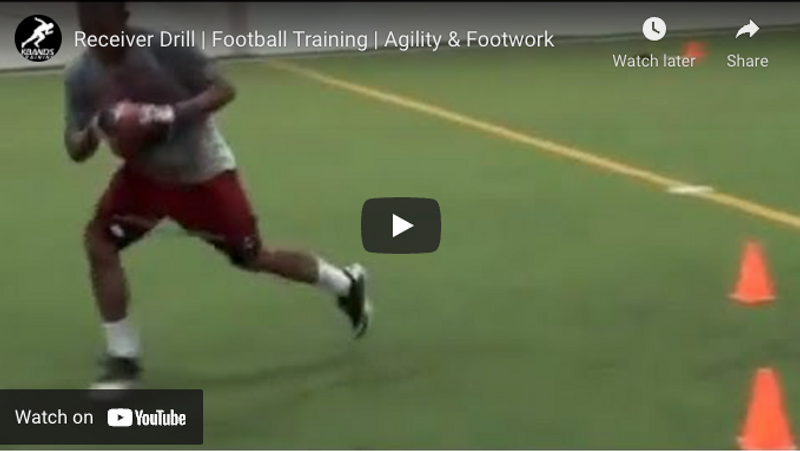Receiver Drills: Improve Agility and Footwork
While the agility and footwork drills described below can help any athlete develop strong reflexes and a long sprinting stride, these drills are specifically designed for receivers. Moves like these, especially with the resistance training support of the Kbands, can help receivers stay responsive and open to the pass without compromising speed, balance, or cutting ability.
Effective receiver drills challenge the athlete in three key ways: 1.) They place strong tension on the muscles of the hips, legs, and core. 2.) They require the athlete to look up while running and receive a pass without changing pace and 3.) they focus on speed development and stride length. The simple set of receiver drills demonstrated in the video below can be worked into any set of training drills targeting receivers, or football players in any position. These drills can also benefit athletes in other sports who need to work on maintaining hand-eye coordination and catching skill while in motion.
Receiver Drills: Setting up the Field
These agility and footwork drills will require three orange training cones. Coaches and players will also need a football, a set of Kbands resistance bands for the legs, and enough space on the field to generate sprinting speed. Each receiver drill will require a participant or player and a partner who can pass the ball.
The first two cones should be placed about three yards apart, and the third should be placed three yards from the other two in an equilateral triangle. Before starting the receiver drills, the player should warm up properly and attach the Kbands straps securely around the upper legs. Then the resistance bands with the appropriate level of tension should be clipped to the straps with the short band in the back and the long band in the front.
Receiver Drills: Agility and Footwork
The player will begin the first set of receiver drills by starting at the first cone in the triangle. The player will break for the second cone, and hug the cone while turning toward the third. At this point, the drill can break into either of two variations. In the first, the partner tosses the ball to the player from a head-on position as he reaches the third cone. In the second version, the partner allows the player to reach third cone, hug the turn, and head into a straight sprint before receiving the pass. In this case, the pass will come from the behind the player, or from a downfield position, which will require the player to turn his head and receive the ball while running in the other direction.
In both cases, the player will need to stay tight against the cones and maintain controlled speed and balance at the turns. And also in both cases, receiving the pass without losing speed will require coordination, control, and attention.
Agility and Footwork: Notes about Technique
Throughout these receiver drills, the purpose of the Kbands is to generate targeted tension in the hips and core. So maintaining a full, natural stride, both on the turns and the straightaway, will require extra attention. Especially while rounding the third cone and heading into the sprint, the football player will experience a tendency to let the bands control his stride and pull his knees down toward the ground. To counter this and gain the maximum benefit from this agility and footwork exercise, the football player will need to actively keep drive the knees up and keep the stride long. With high levels of resistance in place, this won’t be easy, but when the bands are removed during the second round of receiver drills, the temporary feather-light feeling that follows will allow the stride to open and help the football player generate optimal speed.
Receiver Drills: Removing the Resistance Bands
The first set of receiver drills should involve six to eight reps—complete circuits around the cones plus a straightaway sprint-- with the resistance bands in place. The football player running the drills should rest for a few seconds between each rep and should stay focused on strength, coordination, and speed rather than endurance.
After six to eight reps, the football player should remove the bands for the second round of footwork and agility drills. The player should complete four to six rounds with the bands detached, and during these sets, the primary focus should be on using the temporary neurological sensation of lightness to generate speed and stride length.
Notice in the video demonstration how the football player rounds the final cone during the unresisted drills. As he reaches the cone and moves into the turn, his body stays low and balanced, and as soon as he completes the direction change, he looks up and gets ready to receive the pass. He doesn’t wait or complete more than one stride before refocusing his attention from the turn to the pass. As soon as he receives the ball, he turns his focus back to the direction of motion and puts all of his energy into the sprint. During the entire process, he remains in control of balance, speed and direction as well as the location of the ball.

